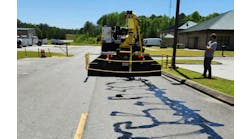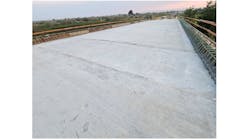By Jo E. Sias, Contributing Author
At 8 a.m. on March 27, the author will deliver a lecture, “Got Weather? Get Asphalt! Asphalt’s Advantages in Resilience to Extreme Events,” at the World of Asphalt Show and Conference in Nashville, Tenn.
As the frequency and severity of extreme weather events increases due to climate change, the resilience of transportation infrastructure becomes critical.
The ability of pavement networks to function during and after an event is central to maintaining economic stability, public safety, and conducting recovery efforts.
Asphalt pavements, which cover a significant portion of the world’s roadways, possess inherent resilient features that can be leveraged to withstand and recover from extreme weather events.
Asphalt pavements not only has properties that provide the ability to endure extreme conditions, but it also includes an adaptive capacity to changing conditions over time and the ability to recover quickly from disruptions.
The Federal Highway Administration (FHWA) defines resilience as the capacity to "anticipate, prepare for, and adapt to changing conditions and withstand, respond to, and recover rapidly from disruptions.”
The Infrastructure Investment and Jobs Act (IIJA) added to the definition “… including the ability: (A) to resist hazards or withstand impacts from weather events and natural disasters or reduce the magnitude or duration of impacts of a disruptive weather event or natural disaster on a project; and (B) to have the absorptive capacity, adaptive capacity, and recoverability to decrease project vulnerability to weather events or other natural disasters.”
This definition emphasizes not just the strength or 'hardening' of the pavement but also its ability to recover after disturbances and to adapt to changing conditions into the future, whether they be climatic extremes or other stressors.
In the specific context of asphalt pavements, resilience translates to the strategic selection of materials in the pavement structure, long-life or perpetual pavement design, and rapid constructability to ensure traffic can resume quickly post-event.
Material selection is a critical component in the design of resilient asphalt pavements. The choice of materials can significantly enhance a pavement's ability to withstand various stressors, adapt to environmental changes over time, and recover from disruptive events.
Selecting an appropriate Performance Graded (PG) asphalt binder that can resist temperature extremes is crucial for resilience.
PG binders are designed to perform in specific temperature ranges, ensuring that the pavement remains flexible enough in intermediate and cold temperatures to resist cracking and stiff enough in hot temperatures to resist rutting.
In regions with high temperature fluctuations or extreme temperatures, additives or modifiers can be used to provide enhanced performance.
Polymer-modified binders (PMBs) can offer enhanced resistance to both rutting and fatigue. PMBs maintain their stiffness at high temperatures and have a more elastic response, which provides increased resistance to rutting.
The improved flexibility of PMBs resists initiation of fatigue and low temperature cracking while increased toughness slows propagation of cracks. The addition of rubber to the binder improves elasticity, enhances flexibility, and increases stiffness to provide increased durability and longevity.
Rubber modified materials can also be used as stress absorbing layers to mitigate reflective cracking. They have been shown to improve adhesion to aggregates and therefore reduce stripping potential.
Anti-stripping agents can be used as well to reduce the potential for moisture damage and increase resistance to stripping.
Warm Mix Asphalt (WMA) technologies can be used to improve the workability of the asphalt mix, allowing for better compaction and, consequently, a more durable and resilient pavement structure.
In areas prone to flooding or heavy rainfall, porous asphalt pavements and open-graded friction courses facilitate rapid drainage of surface water, reducing standing water and the potential for hydroplaning.
Aggregate materials for base and sub-base layers can be selected to allow for rapid drainage and recovery of the load-carrying capacity of the pavement structure.
Aggregate materials with stiffness properties that are less susceptible to changes in saturation level and therefore do not lose as much structural capacity under higher moisture conditions can also be selected. This allows for the fast resumption of traffic on the roadway, particularly for recovery efforts.
Perpetual pavements are designed to last longer than 50 years without requiring major structural rehabilitation or reconstruction, while only needing periodic surface renewal.
The bottom layer is designed to be fatigue resistant to prevent bottom-up cracking. The intermediate layer provides rut resistance and additional structural capacity, and the top layer resists abrasion and top-down cracking.
This durable design provides perpetual pavements with the absorptive capacity to handle changing conditions with respect to traffic and environmental loads.
The design ensures that distresses such as cracking or rutting are confined to the top layer, which can be cost-effectively milled and replaced with materials selected for changing or anticipated climate conditions.
The underlying pavement layers remain intact and structurally strong, avoiding costly and time-consuming reconstruction and contributing to the overall resilience of the pavement.
The strong and relatively thick structure also means that the pavement’s load-carrying capacity is less susceptible to changes in the moisture content of the subgrade materials and therefore is more resilient to flooding events.
Rapid constructability is a term that refers to the ability to quickly and efficiently construct or repair damaged pavements after an event.
This enhances the resilience of the pavement by providing emergency access, facilitating relief and recovery efforts, reducing user delays, and making efficient use of material, equipment, and labor resources during and after the event.
Asphalt pavements are particularly well-suited for rapid constructability for several reasons. Temporary pavements can be placed and compacted quickly, often within hours or days after an event and can support traffic almost immediately, which enables rapid resumption of access for relief and recovery efforts.
Temporary asphalt pavements are easily removed and replaced with a permanent pavement after the event and can serve as a strong foundation for the permanent pavement, enhancing the future resilience of the road to other extreme events.
Asphalt plants can produce hot-mix asphalt on demand. They also can adjust the production rate to align with the pace of construction activities, which facilitates efficient use of available equipment and labor resources.
The use of WMA technologies allows for paving in cooler temperatures and longer haul distances, which can be crucial in post-disaster recovery operations.
Disasters can regularly occur outside of the normal paving season. This may make construction, particularly compaction, difficult. The use of WMA technologies provides a larger window of workability, allowing construction in colder temperatures.
After an event, asphalt plants in the affected area may not be able to operate, so asphalt mixtures must be supplied from plants further away.
Additionally, the use of recycled materials such as reclaimed asphalt pavement (RAP) can enhance the resilience of supply chains by reducing dependence on virgin materials, which may become scarce during disruptive events.
This can also extend to the effective use of storm debris in the reconstruction efforts, reducing the need to haul away materials and the requirements for new materials.
Resilient asphalt pavements also provide substantial economic and environmental benefits through lower life cycle costs and prolonged pavement life, delaying major rehabilitation activities, and conserving resources while reducing GHG emissions over the life cycle.
Sustainable practices such as using recycled materials and WMA technologies contribute to the resilience of pavements by ensuring they are less resource-intensive and adaptable to various conditions.
The resilience of asphalt pavements is a multifaceted concept that extends beyond durability to include adaptability and recovery from disruptions.
With the looming challenges of climate change and the necessity for sustainable infrastructure, asphalt pavements provide opportunities to enhance the resilience of pavement networks.
Through strategic material selection, pavement design, and rapid constructability, resilient asphalt pavements can significantly contribute to the stability and safety of transportation systems during and after extreme events while ensuring economic and environmental sustainability.
As we continue to innovate and adapt, resilient asphalt pavements will play a critical role in the infrastructure of tomorrow. RB
Jo E. Sias, Ph.D., P.E., F.ASCE, is the director of the University of New Hampshire Center for Infrastructure Resilience to Climate.



